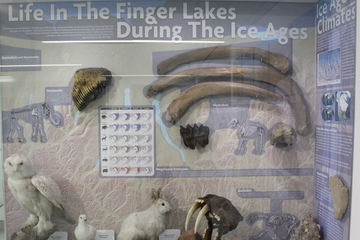Bulletin News

09/12/2017
The updated Ross E. Bowers Hall Science Museum and Greenhouse will formally open with a ribbon cutting ceremony on Thursday, Sept. 28 in the recently renovated science complex’s first floor lobby.
The updated museum will feature a giant, interactive periodic table of elements; an ornithology exhibit featuring preserved passenger pigeons; and a mural that lets visitors “see” what the hills behind Bowers Hall looked like 17,000 years ago.
“Our guiding principles were that whatever was displayed needed to have an interesting story to it, have an educational component to it and it needed to look good,” said Christopher McRoberts, SUNY distinguished professor of geology and curator of the museum. “Our goal is to use that space both for our current students who walk through it, even for teaching in some regards, but also as a space that prospective students and people in the community can visit.”
Campus officials and other dignitaries will offer remarks at the 11 a.m. ribbon cutting. A reception and facility tour will follow the ceremony.
Those wishing to attend are encouraged to R.S.V.P. online by Friday, Sept. 22. Parking will be available in lots A9 and G2 adjacent to the Miller Building. Parking permits are not required, and signage directing visitors to Bowers Hall will be posted. For directions, visit the campus parking map.
McRoberts worked with faculty members from the College’s Biological Sciences, Chemistry and Physics departments to decide what to showcase. Julio Torres Santana, who worked as a project coordinator in the Facilities Planning, Design and Construction Office during the Bowers Hall renovation, helped shape the design of the displays.
The focal point of the museum is a 15-panel mural, “Dreaming of our Ancient Land,” painted by Trumansburg, N.Y.-based artist Barbara Page. The mural depicts an ice-age view from the site of Bowers Hall, looking north toward Tully Valley. The flora, fauna and glaciers in the painting are representative of what would have been found in the region 17,000 years ago.
The mural, created as though there is a picture window in the building that lets visitors see back in time, serves as the background for the geology display case. A pair of erratics, large rocks left when the glaciers melted at the end of the most recent ice age, sit in front of the mural. These geological specimens were collected locally. Geologic studies show that the rocks were originally plucked up by a glacier in Canada and moved south as the glacier grew.
Other items in the geology section of the museum include a display on the area’s stratigraphy — the study of rock layers — and a real-time seismograph station that monitors earthquake activity.
McRoberts did much of the work on the geology displays, writing descriptions for placards, drawing illustrations and mounting samples in display cases.
“I’m a paleontologist, so I’ve worked in museums an awful lot all around the world,” he said. “I understand the value of collections in museums and that was one of the reasons why I was chosen as curator. I have no formal training in museums but I research in museums all the time.”
Biological Sciences has displays focusing on the evolution of birds and modern microscopy. The College’s renowned collection of birds includes endangered and extinct species and was a focal point of the museum prior to the renovations. The collection includes a green jay, a Blackburnian warbler, an eastern screech owl and a red-headed woodpecker, among others.
Physics’ main contributions include technological equipment through history. The Chemistry Department added a massive touchscreen monitor that includes an interactive periodic table of the elements as well as posters from recent undergraduate research projects.
A new greenhouse facility outside Bowers Hall was completed this summer. The greenhouse has three growing areas for tropical, desert and research flora. Steven Broyles, professor and chair of the Biological Sciences Department, acquired approximately 100 rare and unusual plants from the United States Botanic Garden in Washington, D.C. to kick-start the College’s collection.
For more information, contact the Special Events Office at Special.EventsOffice@cortland.edu or 607-753-5453 or 607-753-2377.

